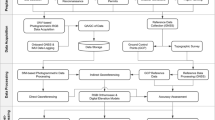Abstract
For space-based optical detection systems, there is usually a difference between actual on-orbit operational performance and designed requirements based on fixed scenarios. To assess the availability of space-based optical detection systems in different backgrounds, the radiation characteristics of aerial targets have been simulated using body radiation and atmospheric transmission models. The background radiation characteristics were also statistically analyzed. Then, for the parameters of the fixed space-based optical detection system, the signal-to-clutter and availability were evaluated under different conditions. A linear relationship between the radiation intensity and the flight height of the target was obtained. For a space-based optical detection system, the analytical availability model was constructed. Finally, multiple groups of data under different simulation conditions were used to validate the universality and reliability of the model. This availability model could significantly reduce the time required to predict the availability of the space-based optical detection system. The model was also adopted to analyze the influence of flight height, mean and variance, and background clutter on the space-based optical detection availability.
Similar content being viewed by others
References
ZHANG K, NI S, YAN D, et al. Review of dim small target detection algorithms in single-frame infrared images[C]//2021 IEEE 4th Advanced Information Management, Communicates, Electronic and Automation Control Conference (IMCEC), June 18–20, 2021, Chongqing, China. New York: IEEE, 2021: 21172519.
DU J, LU H, HU M, et al. CNN-based infrared dim small target detection algorithm using target-oriented shallow-deep features and effective small anchor[J]. IET image processing, 2021, 15(1): 1–15.
YAN P, HOU R, DUAN X, et al. STDMANet: spatio-temporal differential multiscale attention network for small moving infrared target detection[J]. IEEE transactions on geoscience and remote sensing, 2023, 61: 1–16.
DAI Y, WU Y, ZHOU F, et al. Attentional local contrast networks for infrared small target detection[J]. IEEE transactions on geoscience and remote sensing, 2021, 59(11): 9813–9824.
LIU Z, LI X. Study on working mechanism and detection parameters of SBIRS-GEO early warning satellites[J]. Laser & infrared, 2018, 48(3): 363–368.
CHEN L, CHEN X, RAO P, et al. Space-based infrared aerial target detection method via interframe registration and spatial local contrast[J]. Optics and lasers in engineering, 2022, 158: 107131.
DU P, HAMDULLA A. Infrared small target detection using homogeneity-weighted local contrast measure[J]. IEEE geoscience and remote sensing letters, 2020, 17(3): 514–518.
ZHANG J, QI H, JIANG D, et al. Integrated infrared radiation characteristics of aircraft skin and the exhaust plume[J]. Materials, 2022, 15(21): 7726.
HUANG W, JI H. Effect of environmental radiation on the long wave infrared signature of cruise aircraft[J]. Aerospace science and technology, 2016, 56: 125–134.
LI J, ZHAO H, GU X, et al. Analysis of space-based observed infrared characteristics of aircraft in the air[J]. Remote sensing, 2023, 15(2): 535.
YUAN H, WANG X, YUAN Y, et al. Modeling and analysis of aircraft full-chain imaging characteristics in the sea surface and clouds from a space-based platform[J]. Infrared and laser engineering, 2020, 49(2): 0204004.
HE X, XU X. Optimal band analysis for dim target detection in space-variant sky background[J]. Proceedings of SPIE 10795, electro-optical and infrared systems: technology and applications XV, 2018: 107950N.
YU S, NI X, LI X, et al. Real-time dynamic optimized band detection method for hypersonic glide vehicle[J]. Infrared physics and technology, 2022, 121: 104020.
ZHOU X, NI X, ZHANG J, et al. A novel detection performance modular evaluation metric of space-based infrared system[J]. Optical and quantum electronics, 2022, 54: 274.
ZHU H, RAO P, CHEN X. Infrared system simulation of airborne target detection on space-based platform[J]. Proceedings of SPIE 11159, electro-optical and infrared systems: technology and applications XVI, 2019: 111590R.
Author information
Authors and Affiliations
Corresponding author
Ethics declarations
Conflicts of interest
The authors declare no conflict of interest.
Additional information
This work has been supported by the National Natural Science Foundation of China (No.62004122).
Rights and permissions
About this article
Cite this article
Zhao, J., Zhang, L., Ding, X. et al. Availability evaluation model for space-based optical aerial target detection system. Optoelectron. Lett. 19, 599–604 (2023). https://doi.org/10.1007/s11801-023-3038-5
Received:
Revised:
Published:
Issue Date:
DOI: https://doi.org/10.1007/s11801-023-3038-5




